10 Tauri
| Observation data Epoch J2000 Equinox J2000 | |
|---|---|
| Constellation | Taurus |
| Right ascension | 03h 36m 52.38s[1] |
| Declination | +00° 24′ 06.0″[1] |
| Apparent magnitude (V) | 4.29[2] |
| Characteristics | |
| Spectral type | F8 V[3] |
| U−B color index | +0.08[2] |
| B−V color index | +0.58[2] |
| Astrometry | |
| Radial velocity (Rv) | +27.8±0.5[4] km/s |
| Proper motion (μ) | RA: −232.60±0.59[1] mas/yr Dec.: −481.92±0.54[1] mas/yr |
| Parallax (π) | 71.62 ± 0.54 mas[1] |
| Distance | 45.5 ± 0.3 ly (14.0 ± 0.1 pc) |
| Absolute magnitude (MV) | +3.60[5] |
| Details[6] | |
| Mass | 1.139±0.016 M☉ |
| Radius | 1.622±0.024 R☉ |
| Luminosity | 3.042±0.042 L☉ |
| Surface gravity (log g) | 4.06±0.03[7] cgs |
| Temperature | 6,000±59[7] K |
| Metallicity [Fe/H] | −0.08±0.01[7] dex |
| Rotation | 17.6 days[8] |
| Rotational velocity (v sin i) | 2.4[5] km/s |
| Age | 5.7±0.4 Gyr |
| Other designations | |
| Database references | |
| SIMBAD | data |
10 Tauri is a single[9] star in the zodiac constellation of Taurus. It can be seen with the naked eye, having an apparent visual magnitude of 4.29.[2] An annual parallax shift of 71.62[1] mas provides a distance estimate of 45.5 light years. It is moving further from the Sun with a radial velocity of +28 km/s[4] and has a relatively high proper motion.[2]
The star has a stellar classification of F8 V,[3] indicating that it is an ordinary F-type main-sequence star that is generating energy through hydrogen fusion in its core region. It is around 5.7[6] billion years old with a rotation period of 17.6 days.[8] The star has 1.14 times the mass of the Sun and 1.6 times the Sun's radius. It is radiating three[6] times the Sun's luminosity from its photosphere at an effective temperature of 6,000 K.[7]
A debris disk has been identified orbiting 10 Tauri, based on excess infrared radiation detected by IRAS/ISO.[10]
10 Tauri was the brightest star in the obsolete constellation Psalterium Georgii (Harpa Georgii).[11]
References
[edit]- ^ a b c d e f van Leeuwen, F. (2007). "Validation of the new Hipparcos reduction". Astronomy and Astrophysics. 474 (2): 653–664. arXiv:0708.1752. Bibcode:2007A&A...474..653V. doi:10.1051/0004-6361:20078357. S2CID 18759600. Vizier catalog entry
- ^ a b c d e Cowley, A. P.; et al. (December 1967), "Spectral classification and photometry of high proper motion stars", Astronomical Journal, 72: 1334−1340, Bibcode:1967AJ.....72.1334C, doi:10.1086/110413.
- ^ a b Houk, N.; Swift, C. (1999), "Michigan catalogue of two-dimensional spectral types for the HD Stars", Michigan Spectral Survey, 5, Bibcode:1999MSS...C05....0H.
- ^ a b Nordström, B.; et al. (May 2014), "The Geneva-Copenhagen survey of the Solar neighbourhood. Ages, metallicities, and kinematic properties of ~14000 F and G dwarfs", Astronomy and Astrophysics, 418: 989–1019, arXiv:astro-ph/0405198, Bibcode:2004A&A...418..989N, doi:10.1051/0004-6361:20035959, S2CID 11027621.
- ^ a b Pizzolato, N.; Maggio, A.; Sciortino, S. (September 2000), "Evolution of X-ray activity of 1-3 Msun late-type stars in early post-main-sequence phases", Astronomy and Astrophysics, 361: 614–628, Bibcode:2000A&A...361..614P
- ^ a b c Boyajian, Tabetha S.; et al. (February 2012), "Stellar Diameters and Temperatures. I. Main-sequence A, F, and G Stars", The Astrophysical Journal, 746 (1): 101, arXiv:1112.3316, Bibcode:2012ApJ...746..101B, doi:10.1088/0004-637X/746/1/101, S2CID 18993744. See Table 10.
- ^ a b c d Soubiran, C.; Creevey, O. L.; Lagarde, N.; Brouillet, N.; Jofré, P.; Casamiquela, L.; Heiter, U.; Aguilera-Gómez, C.; Vitali, S.; Worley, C.; de Brito Silva, D. (2024-02-01). "Gaia FGK benchmark stars: Fundamental Teff and log g of the third version". Astronomy and Astrophysics. 682: A145. arXiv:2310.11302. Bibcode:2024A&A...682A.145S. doi:10.1051/0004-6361/202347136. ISSN 0004-6361. 10 Tauri's database entry at VizieR.
- ^ a b Maldonado, J.; et al. (October 2010), "A spectroscopy study of nearby late-type stars, possible members of stellar kinematic groups", Astronomy and Astrophysics, 521: A12, arXiv:1007.1132, Bibcode:2010A&A...521A..12M, doi:10.1051/0004-6361/201014948, S2CID 119209183
- ^ Rodriguez, David R.; et al. (May 2015), "Stellar multiplicity and debris discs: an unbiased sample", Monthly Notices of the Royal Astronomical Society, 449 (3): 3160–3170, arXiv:1503.01320, Bibcode:2015MNRAS.449.3160R, doi:10.1093/mnras/stv483.
- ^ J.S. Greaves; D.A. Fischer; M.C. Wyatt (2006). "Metallicity, Debris Discs and Planets". Monthly Notices of the Royal Astronomical Society. 366 (1): 283–286. Bibcode:2006MNRAS.366..283G. doi:10.1111/j.1365-2966.2005.09848.x.
- ^ Ian Ridpath's Star Tales - Psalterium Georgii
External links
[edit]- "* 10 Tau". SIMBAD. Centre de données astronomiques de Strasbourg. Retrieved 2006-08-10.
- "4C00315". ARICNS. 1998-03-04. Archived from the original on 2011-06-07. Retrieved 2006-08-10.
- "10 Tauri". Internet Stellar Database. Retrieved 2006-08-10.

